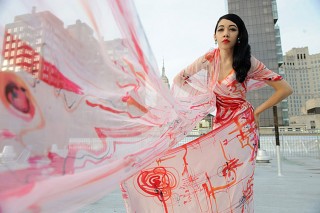Column Name
Title
Subhead

Harpist and fashion designer Arielle works for Zeduce Media with photographer Wendell Teodoro, who took this picture of her.
(Photo by Wendell Levi Teodoro)Most Juilliard students are of necessity pretty single-minded, but the artist who's now known just as Arielle (MM ’09, harp) has had dual identities—in music and fashion—since childhood. At age 4, she started studying the piano, soon adding voice, composition, and harp to her repertoire. But she also started sewing around the same time. Now known simply as Arielle, she designs clothes and has become a regular on the New York Fashion Week scene. She’s the fashion editor and “creative catalyst” at Zeduce Media, a Sydney (Australia)-based photography company. And after a year-and-a-half hiatus from performing prompted by a sprained thumb, she’s starting to play the harp again, reviving Duo Mango, which she formed with Chelsea Chen (MM ’06, organ) when they were at Juilliard. She spoke with The Journal recently about her multifaceted career and the role Juilliard played in forming it.
Body
Which of your interests was sparked first—music or fashion?
They came about at the same time. My mother started me with piano lessons, but I also started to hand-sew, and I remember my grandmother teaching me how to crochet. I would make little stuffed animals and doll clothes.
You must have seen a musical career for yourself when you auditioned for Juilliard. Were you ever set on a life of orchestral performance?
I never had the intention of being a full-time orchestral musician. I actually had applied for both music and fashion for my undergrad, but decided to study music first because it made the most sense for athletic reasons [that is, physically keeping up with her harp technique]. I trained in the harp for so long, but I was just starting to find my technique and it was definitely the right time to finish that.
How did Juilliard prepare you for your work in fashion?
The Juilliard experience is what you make out of it. It really prepares you to carve out your own sphere, your own direction, and your own path. I completed the Scholastic Distinction project [the paper was on clothing in classical music performances], studied theatrical makeup through the Drama Division, and performed with a lot of dancers while also working with them on costume and styling. And through that, I developed some private [fashion] clients.
What are some of the intersections between the classical music and contemporary fashion worlds?
They come together on the stage—or they’re supposed to, at any rate. My Scholastic Distinction project began as a result of seeing a lack of fashion in classical music, and a lack of a strong, forceful visual presence in classical concerts. I think that in trying to market yourself as an artist, even as a classical one, you have to be aware of your visual presence because the strongest package is what’s going to be bought, and that’s absolutely true if you’re trying to make a living off your art form.
Who has influenced you?
I don’t want to go into specifics because I would leave someone out. In fashion, I avoid listing specific designers because I mostly like individual garments. So rather than saying I like one person and all of their work, I tend to cherry-pick. And that’s also true of musical performances and performers. It’s sometimes difficult to tell exactly where inspiration came from for any given project.
How did you get involved with Zeduce Media?
I’ve been involved in New York Fashion Week for three or four seasons, and I met our head photographer Wendell Teodoro at a couple of fashion shows and he photographed me. We exchanged contact information and as he kept coming back (he’s based in Sydney), we became friends and realized we shared a lot of performing-arts interests and general artistic explorations. I ended up becoming a part of the New York Zeduce team, and I also recruited violinist and photographer Arthur Moeller (M.M. ’09, violin) to join us. I’m what we call the “creative catalyst,” which means I do a lot of networking and work with PR companies, but I also help manage logistics for my team in terms of access to various events.
If you could design your ideal job, what would it look like?
I’d love to do both music and fashion. But I’d also love to completely support my life with fashion so I could take on whatever interesting musical projects without having to worry about negotiating a musical fee. That’s always been my goal. I love to encourage young composers and projects that are underfunded but are of good artistic value. Ideally, I would have my own company, but that is very far down the road.




